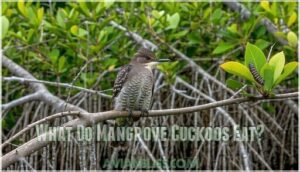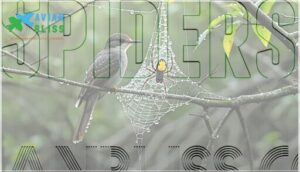This site is supported by our readers. We may earn a commission, at no cost to you, if you purchase through links.

This secretive bird has mastered life in saltwater-adjacent environments, preferring dense mangrove swamps where it feeds primarily on caterpillars, insects, and spiders.
Unlike the yellow-billed cuckoo that migrates widely, the mangrove cuckoo stays put year-round in its specialized habitat.
Its buff-colored belly and brownish back help it blend into the dappled light of mangrove canopies.
You’re more likely to hear its distinctive call than spot this elusive species, which makes patient observation essential.
Their specific dietary preferences and unique habitat requirements reveal fascinating adaptations.
Table Of Contents
- Key Takeaways
- Where Are Mangrove Cuckoos Found?
- Habitat of Mangrove Cuckoos
- What Do Mangrove Cuckoos Eat?
- Dietary Habits of Mangrove Cuckoos
- Difference Between Yellow-Billed Cuckoo and Mangrove Cuckoo
- Frequently Asked Questions (FAQs)
- Where do mangrove cuckoos live?
- What is a mangrove cuckoo?
- Are mangrove cuckoos secretive?
- Where is the mangrove cuckoo in Florida?
- Do mangrove cuckoos eat small birds?
- Are mangrove cuckoos declining?
- What is the difference between Yellow-billed Cuckoo and Mangrove Cuckoo?
- What is the cuckoo bird controversy?
- What are the predators of the Mangrove Cuckoo?
- Where are Mangrove Cuckoos found?
- Conclusion
Key Takeaways
- You’ll find mangrove cuckoos only in coastal mangrove forests from South Florida through Central America and the Caribbean, where they stay year-round instead of migrating like other cuckoo species.
- You’re more likely to hear than see these secretive birds due to their elusive nature and buff-colored camouflage that blends perfectly with dappled mangrove canopy light.
- They’re specialized insect hunters that use a patient "sit and wait" strategy to catch caterpillars, grasshoppers, moths, beetles, and spiders, plus occasional small lizards and fruits.
- You can distinguish them from yellow-billed cuckoos by their distinctive black facial mask, robust black-and-yellow bill, buffy underparts, and preference for staying in coastal mangroves rather than migrating inland.
Where Are Mangrove Cuckoos Found?
The mangrove cuckoo calls tropical regions across the Americas home, with its geographical range stretching from southern Florida through the Caribbean to northern South America.
You’ll find these secretive birds thriving in coastal mangrove ecosystems from Cuba and Jamaica down to Brazil’s Atlantic coast.
Unlike many bird species, mangrove cuckoos don’t follow typical migration patterns—they’re year-round residents who stick close to their chosen territories.
Their habitat diversity includes dense mangrove swamps, tropical hardwood hammocks, and scrubby coastal forests.
In Florida, they’re particularly common in the Keys and Everglades.
These birds serve as living indicators of healthy mangrove systems.
When you spot one during breeding season, you’re witnessing nature’s perfect match between species and habitat.
Their breeding grounds remain consistent throughout their range, making them reliable ambassadors for tropical regions where land meets sea.
To find mangrove cuckoos and other species, understanding local bird habitats is essential for successful birdwatching.
Habitat of Mangrove Cuckoos
You’ll discover these secretive birds in some of the most specialized habitats on Earth, where dense vegetation provides perfect cover for their elusive lifestyle.
Where mangrove roots meet saltwater, secretive cuckoos find their perfect hideaway in nature’s most exclusive neighborhoods.
Mangrove cuckoos require very specific environmental conditions to thrive, making their habitat preferences both fascinating and critically important for their survival.
Mangrove Swamps
In mangrove swamps, you’ll discover the mangrove cuckoo’s primary home where mangrove trees create perfect hiding spots.
These coastal mangrove ecosystems offer dense canopy cover exceeding 70%, providing ideal mangrove habitat conditions.
Swamp ecology thrives here, supporting diverse wildlife while delivering vital ecosystem services:
- Natural protection from coastal erosion
- Storm surge buffering for communities
- Carbon storage through healthy wetlands
- Essential breeding grounds for cuckoos
Understanding unique bird habitats is crucial for effective conservation efforts.
Effective wetland management and mangrove conservation guarantee these remarkable birds continue flourishing in their specialized environment.
Coastal Forests
Beyond the mangrove swamps, these elusive birds also call coastal forests home.
You’ll find mangrove cuckoos using adjacent hardwood hammocks where mangrove habitat meets upland trees.
Forest ecology studies show they forage along forest edges near brackish water, with tree canopy coverage providing shelter.
However, human development reduces available coastal ecosystems by 13% per decade.
Coastal conservation efforts and mangrove restoration projects through ecosystem management help protect these bird conservation priorities.
Understanding mangrove birding techniques is essential for effective conservation.
Status: Under conservation—vulnerable due to habitat loss.
Islands
Caribbean islands and the Lesser Antilles provide perfect strongholds for these secretive tropical birds.
You’ll discover stable populations thriving where mangrove belts remain undisturbed by coastal erosion and development pressures.
Island Geography creates natural refuges that support healthy Tropical Biodiversity.
- Protected islands show increased Mangrove Cuckoo breeding success through targeted Island Conservation efforts
- Uninhabited areas maintain dense canopy cover essential for bird habitat stability
- Marine Life connections guarantee abundant insect prey within mangrove root systems
What Do Mangrove Cuckoos Eat?
You’ll be fascinated by the diverse food sources that fuel these secretive birds. Mangrove Cuckoos are primarily insectivorous, making them nature’s pest control specialists.
Their hunting tactics involve patient observation from concealed perches, using their keen eyesight to spot movement below. These skilled hunters employ a "sit and wait" approach for prey capture. They’ll remain motionless for extended periods before quickly snatching unsuspecting targets.
Their feeding habits center around three main categories:
- Insects – Caterpillars, grasshoppers, moths, and beetles form their primary nutrient intake
- Invertebrates – Spiders found throughout mangrove vegetation provide essential protein
- Fruits – Occasional plant matter supplements their otherwise carnivorous bird diet.
Their foraging behavior involves deliberate, slow movements through the canopy. You’ll rarely see them flying between branches – instead, they hop and walk silently from perch to perch. This methodical approach allows them to surprise prey while conserving energy in their humid habitat.
Dietary Habits of Mangrove Cuckoos
You’ll find that mangrove cuckoos have quite specific feeding habits that match their secretive lifestyle.
These birds use a "sit and wait" hunting strategy, remaining perfectly still before quickly snatching insects, spiders, small lizards, and occasional fruits from the dense mangrove canopy.
Insects
You’ll find that insects make up the bulk of what mangrove cuckoos eat.
These insectivorous birds are skilled hunters, targeting caterpillars, grasshoppers, moths, and beetles with precision.
Their Insect Prey varies based on seasonal availability and Grasshopper Habitats.
The cuckoo’s Caterpillar Diet includes large, hairy species that other birds avoid.
Moth Species active at dawn provide easy targets, while Beetle Behavior patterns help cuckoos predict where to hunt.
This invertebrates focus keeps them well-nourished year-round.
Understanding their diet requires knowledge of insect food sources.
Spiders
While insects make up most of their meals, mangrove cuckoos also hunt spiders with impressive skill.
You’ll spot them carefully examining spider webs and plucking web spinners from their silk homes.
Their feeding behavior shows remarkable patience as they study spider behavior before striking.
- Spider prey provides essential proteins for growing chicks
- Venom types don’t deter these fearless hunters
- Complex diet details reveal spiders as consistent nutrition sources
Small Lizards
Beyond spiders, you’ll find that the mangrove cuckoo bird has quite an appetite for small species of reptiles.
These patient hunters expand their menu beyond insects to include small reptiles as protein-rich prey.
This bird species targets lizards as a key part of its reptile diet, using specialized cuckoo hunting techniques.
You’ll notice these cuckoo birds employ a "sit and wait" strategy, remaining perfectly still before snatching unsuspecting lizard prey.
Their camouflaged plumage helps them blend into mangrove branches, making them nearly invisible to their targets.
What’s fascinating is how mangrove cuckoos can handle toxic lizards that other predators avoid.
This lizard behavior adaptation gives them access to prey others can’t touch.
Small frogs also fall victim to their patient hunting style, providing essential protein for these coastal specialists.
Fruits
Besides consuming insects and small lizards, you’ll find that mangrove cuckoo fruit foraging plays a key role in their diet.
These bird species show remarkable adaptability in their Fruit Consumption patterns across the Neotropics. Their Berry Eating habits contribute substantially to Seed Dispersal, supporting ecosystem health and their conservation status.
The mangrove cuckoo’s diet is also influenced by available mangrove fruit products.
Tropical Fruits in their diet include:
- Small berries from coastal shrubs and mangrove-adjacent vegetation
- Soft, fleshy fruits that ripen during peak foraging seasons
- Native fruit varieties rich in nutrients and easily digestible seeds
Difference Between Yellow-Billed Cuckoo and Mangrove Cuckoo
While their diets may overlap, these two cuckoo species show clear differences in bird identification features.
The mangrove cuckoo displays a distinctive black facial mask, while the Yellow-Billed Cuckoo lacks this marking.
Bill Color varies substantially – mangrove cuckoos have robust bills with black upper mandibles, whereas yellow-billed cuckoos show slender beaks with yellow coloring on lower portions.
Size Differences
Plumage Variation
Vocal Patterns
Beak Shape differs markedly between species.
Nesting Habits also separate them – yellow-billed cuckoos prefer deciduous woodlands while mangrove cuckoos stick to coastal mangroves.
Understanding cuckoo conservation efforts is vital for protecting these species.
This bird comparison reveals that yellow-billed cuckoos migrate extensively from eastern U.S. to South America, but mangrove cuckoos remain coastal residents year-round, making cuckoo species identification straightforward once you know what to look for.
Frequently Asked Questions (FAQs)
Where do mangrove cuckoos live?
Coastal creatures call mangrove swamps home! You’ll find these secretive birds in Florida‘s mangroves, Caribbean islands, Mexico, and Central America’s dense coastal forests, where they forage quietly.
What is a mangrove cuckoo?
You’ll find a mangrove cuckoo is a secretive, medium-sized bird with brown plumage, a curved yellow-and-black bill, and distinctive white tail spots that thrives in coastal mangrove forests.
Are mangrove cuckoos secretive?
Yes, you’ll find mangrove cuckoos are extremely secretive birds.
They perch motionless in thick vegetation, making them notoriously difficult to spot.
They rarely vocalize and move deliberately through dense canopy, preferring to stay hidden.
They are difficult to observe due to their behavior and habitat preferences.
Where is the mangrove cuckoo in Florida?
You’ll find these elusive birds in southern Florida’s mangrove swamps, particularly in the Keys and coastal mainland areas.
They also inhabit tropical hardwood hammocks and dense scrubby woodlands throughout their range.
Do mangrove cuckoos eat small birds?
You won’t find small birds on their menu. These secretive hunters stick to insects like caterpillars, grasshoppers, and moths, plus occasional spiders, small frogs, and fruits for variety.
Are mangrove cuckoos declining?
Population trends show concerning declines, especially in Florida where you’ll find habitat loss threatening these secretive birds.
Partners in Flight notes declining U.S. populations, though global numbers remain around 200,000 breeding pairs.
The main threat to their survival is due to climate change effects on their habitats, which is a significant concern for their well-being and survival.
What is the difference between Yellow-billed Cuckoo and Mangrove Cuckoo?
Like twin cousins at a family reunion, you’ll spot key differences once you know what to look for.
Mangrove Cuckoos sport warmer buff coloring, a more obvious black facial mask, and grayer crowns compared to Yellow-billed Cuckoos’ peachy wash.
What is the cuckoo bird controversy?
You’re facing the cuckoo’s reputation as nature’s ultimate trickster.
These birds use brood parasitism, laying eggs in other birds’ nests and tricking foster parents into raising their young.
Your cuckoo chick pushes out host eggs, monopolizing care while their real offspring starve.
This behavior is a classic example of brood parasitism strategies that have fascinated scientists and the general public alike, showcasing the cuckoo’s unique approach to survival.
What are the predators of the Mangrove Cuckoo?
You’ll face threats from hawks, snakes, and raccoons. Hawks hunt adult cuckoos while snakes and raccoons raid nests targeting eggs and chicks, making dense mangrove habitat essential for survival.
Where are Mangrove Cuckoos found?
Coincidentally spotted in warm coastal waters, you’ll find these secretive birds inhabiting mangrove swamps from southern Florida through the Caribbean, Mexico, Central America, and South America’s Atlantic coast.
Conclusion
Like a master key fitting only one lock, the mangrove cuckoo has perfectly adapted to its coastal world.
You’ve discovered how this specialized bird thrives in saltwater environments, from its buff-colored camouflage to its insect-heavy diet. Unlike its yellow-billed cousin that roams widely, the mangrove cuckoo stays loyal to its mangrove home year-round.
Remember, patience pays off when searching for this secretive species – listen carefully for its distinctive call echoing through the coastal canopy.












